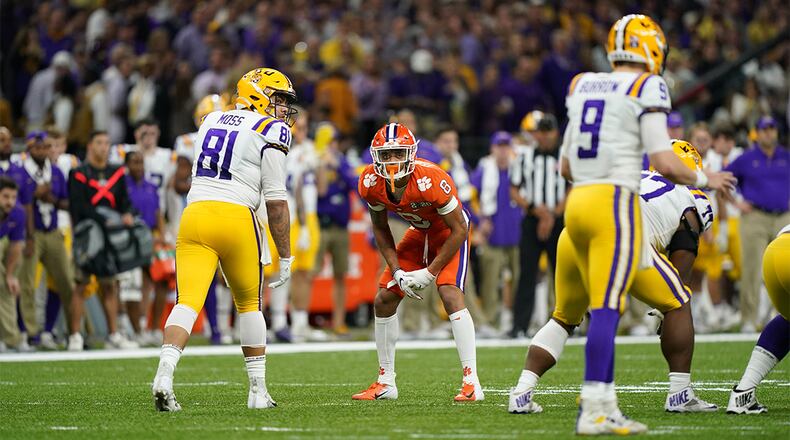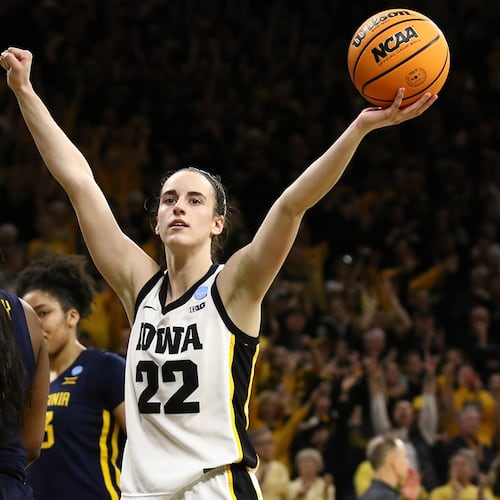Let’s be honest: The Falcons’ chance to reap a draft windfall was lost in December, when they won four games after their postseason hopes had been mathematically quashed. Had they gone 2-2 instead – remember, the victories over San Francisco and Tampa Bay were hairbreadth things – they’d have held no worse than the No. 8 pick in Round 1.
Cornerback CJ Henderson, the apparent apple of their eye, was taken by Jacksonville at No. 9.
Then again, had the Falcons gone 5-11, different people would surely have exercised these picks, and who knows what their preferences would have been? So: moot point.
More honesty: It would have taken a heapin’ helpin’ of draft dexterity for a team with the 16th pick and six selections over seven rounds to have made outright hay. The guess is that Thomas Dimitroff – Trader Tom – did his usual utmost to move upward and onward, but this time he found no takers. (Hey, it happens.)
Thus was A.J. Terrell cast in the role of cornerstone cornerback, which he mightn't be. The next time any GM says, "We always take the best player available," think of Terrell at No. 16 and feel free to quibble. With Desmond Trufant gone, they needed a cornerback in the worst way. They're in a division with Drew Brees and Michael Thomas and Mike Evans and ... oh, yeah, Tom Brady. Somebody better patrol that proverbial island. Is Terrell that guy?
Personal confession: I’d be more inclined to answer “yes,” had the last football game I covered not featured the Falcons’ Round 1 pick being all but chased off the field by a receiver named Chase. The LSU wideout, whose first name is Ja’Marr, caught two touchdown passes against Clemson’s Terrell. Chase had 162 yards – he’d finish with 221 –in the first half, leading Dabo Swinney to say at halftime: “A couple of throws to No. 1 (Chase) were just great plays.”
Which they were, but still: Terrell was culpable for three LSU touchdowns. He got shredded – albeit by some big-time receivers and an all-time great collegiate quarterback – in the way the Falcons' Charles Dimry was shredded on the 1990 Sunday when Jerry Rice caught five touchdowns against the men of Glanville. ESPN's Mel Kiper had Terrell rated the 61st-best player available; the Falcons took him 45 spots ahead of that. Yeah, that's a reach.
Their Round 2 pick – defensive end Marlon Davidson of Auburn – was another nod to reality: For all the draft capital spent on pass rushers and the many coordinators commissioned to prop up this defense, it remains substandard. As middle-of-Round-2-picks go, he's fine. Davidson got lost in the rush to laud teammate Derrick Brown, taken seventh overall by Carolina, but let's recall that the Falcons' best defender, Grady Jarrett, arrived in Round 5 in 2015 -- 129 picks after his more heralded teammate Vic Beasley.
(Note: Dan Quinn said early Saturday that Davidson could play more inside -- alongside Jarrett -- than at end.)
Round 3 brought Matt Hennessy, an offensive lineman from Temple. That can be read as cover for the left guard spot held by James Carpenter and acknowledgement that incumbent center Alex Mack, whose addition in 2016 galvanized a line that turned Matt Ryan into an MVP and the Falcons into a Super Bowl team, will turn 34 in November. Not a sexy pick, but O-linemen never are.
Said Dimitroff: “We went into this night focused on the interior, getting stronger, bigger, more versatile inside both offensively and defensively. We accomplished our goals ... We did it. We were fortunate not to give up any draft capital, which was important for us as well.”
Saturday's Round 4 brought two more defenders -- linebacker Mykal Walker of Fresno State and safety Jaylinn Hawkins of California. In the immediate future, we're likely to see them on special teams. That's not a criticism. That's just how it works.
Cap concerns cost the Falcons not just Trufant but linebacker De’Vondre Campbell, a 2016 fourth-rounder, and Beasley, the first draftee of Quinn’s stewardship. Given that this front office has had five seasons to build, an awful lot of holes have developed. That’s how you go from a Super Bowl to consecutive losing seasons in three years. No longer is this the NFL’s next great team; it’s now one that’s trying to stay afloat.
Because their draft position made a bountiful draft unlikely if not improbable, the Falcons’ big offseason work figured to be done in free agency. They signed three former Round 1 picks – Todd Gurley, Dante Fowler and LaQuon Treadwell – who’d been deemed surplus to requirements by their former employers.
Alongside that group, the first three members of this rookie class are fairly unassuming. There’s a cornerback coming off the worst game of his life, another in the series of pass-rush candidates and a center from the American Conference. This isn’t necessarily a bad yield, but honesty compels me to report that it’s my least favorite Falcons draft in a while. I had no problem with Beasley. I kind of liked the pick of Keanu Neal. I saw the rationale behind the double-OL Round 1 of last year.
But this draft? It’s just OK. Maybe it was always going to be only OK. Maybe we on the periphery put too much stock in Dimitroff’s trading acumen and couldn’t see past the reality: Their first three picks were Nos. 16, 47 and 78. You’re not apt to bank a Grade-A group with that currency, and they didn’t.
About the Author
The Latest
Featured



